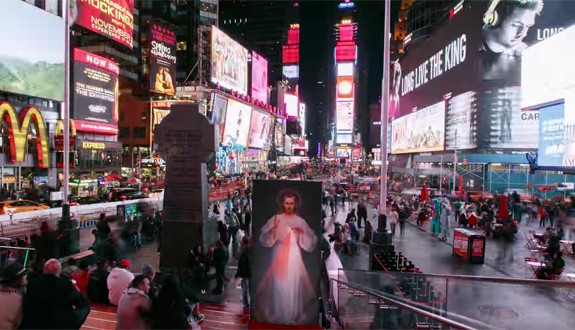

Director Daniel DiSilva has wanted to tell the story of the Divine Mercy devotion for a long time. His new documentary film, The Original Image of Divine Mercy, follows DiSilva and his film crew as they travel throughout Europe and the United States interviewing a variety of prominent people about the Divine Mercy devotion and the story of the original image of Divine Mercy.
The devotion is based on a private revelation to Polish nun St. Faustina Kowalska (1905-38) as described in her diary; in 1931, she said that Christ asked her to have the image of Divine Mercy painted and shared with the world. Despite the destruction brought by World War II and the Soviet domination of Eastern Europe in its aftermath, remarkably the image has survived and is today venerated in a 24-hour shrine in Vilnius, Lithuania.
The Divine Mercy image is of importance to DiSilva personally, as it played a role in bringing him back to the Catholic faith of his youth, and after hearing the story of the original image’s survival, he wanted to share it with the world through film. He recently spoke with CWR.
CWR: How did you first learn about the Divine Mercy devotion?

Daniel DiSilva: I was born in Chicago, and grew up in an Italian neighborhood. We attended a Lithuanian parish. But, growing up in the 70s, I drifted from the Faith, and went the way of a lot of young people. I was a secular musician, and without going into any details, I’ll just say I lived the life of a typical secular musician.
At this time, a woman in my apartment complex gave me a picture of the Divine Mercy. I was too busy living my secular lifestyle to pay any attention at first. In 1999, however, I met Christopher West and heard his presentation on the Theology of the Body. I came to realize the beauty of Church teaching.
I grabbed that Divine Mercy picture and began to pray. I had a major turnaround in my life based on the devotion to the Divine Mercy.
My dad, Rudy, had an experience somewhat like mine. He was Catholic and was not practicing his faith for some time. When he was on his deathbed in 2006, I would go to his bedside and pray the Divine Mercy prayers with him. He returned to the Faith, and passed away saying those prayers. It was a special bond for us.
CWR: You had a Christian band for 10 years.
DiSilva: Yes, it was named Crispin, after St. Crispin. We toured the world for 10 years.
It was while doing Crispin’s final concert in Eastern Europe in 2009 that I got the idea to make the Divine Mercy film. I was introduced to a priest in Lithuania who asked me, “Do you want to spend the night with Jesus tonight?”
Our tour host assured me the priest was on the up-and-up, so I said yes, and went with him. He took me to the church, before it became a 24-hour shrine, where the original image of the Divine Mercy is displayed. He said he’d lock me in for the night, and let me out in the morning when he came to say morning Mass. He requested I write a testimony afterwards for a book he was compiling on the Divine Mercy.
So, I stayed there the night. Ever since then, I realized that God’s mercy was available to us in massive quantities if we wanted it. I didn’t understand that before then…in fact, I think I’m still trying to understand it.
CWR: Your film features many prominent people, including Cardinal Christoph Schönborn, George Weigel, Bishop Robert Barron, comedian Jim Gaffigan, and musician Harry Connick, Jr. How did you get them to participate?
DiSilva: I was persistent and fortunate. For example, I went on a date to a Jim Gaffigan show in San Diego. The woman with whom I went was saying afterwards that it was neat that Jim is a Catholic. She was an actress, in fact, and had recorded a pilot with him. She had his email address, and suggested I contact him about being in the film.
Within 10 minutes, he responded. He said he thought the film was an awesome idea. He had a great devotion to the Divine Mercy, and his wife had an even greater devotion. He agreed to be part of it.
We went to his apartment in New York and filmed him. His wife didn’t want to appear on camera, but you can see him looking off camera to her for support as we film.
Harry Connick, Jr. is another prominent entertainer we interviewed. He played the organ for us in St. Patrick’s Cathedral in New York City. He plays “How Great Thou Art” in an unusual New Orleans style and talks about it as he plays.
We contacted Mr. Connick through his manager, who asked us many questions before presenting our request to Mr. Connick. His was one of the last interviews we did.
I had originally written to Chicago’s Mundelein seminary, where [Bishop Barron] was teaching, to request his participation. He was filming in Greece at the time, but our calendars eventually matched up and we got him to participate.
We also got some cardinals to participate. We went to Austria, for example, to interview Cardinal Christoph Schönborn, the archbishop of Vienna, and to Kraków, Poland, to meet with Cardinal Stanislaw Dziwisz. It was also in Kraków that we interviewed George Weigel; he teaches a class there each year.
We’ll be releasing a DVD of the film this fall, which will have an interview with Immaculée Ilibagiza, who survived the Rwandan genocide nearly 20 years ago. She has written about the power of forgiveness in her life.
Individuals will have the opportunity to buy the DVD this Thanksgiving; they’ll also be able to pay-per-view online at that time. Right now, we’re encouraging people to coordinate viewing through their parishes, groups, or even their homes. I also do a Director’s Cut film presentation, where I come personally and present the film.
CWR: Tell me about your use of music in the film.
DiSilva: We have some outstanding music which we like to highlight when we talk to people about the film. One of the musicians we use is Mike Mangione; old-timers might be familiar with his uncle Chuck Mangione. Mike plays music as a component of Christopher West’s Theology of the Body week-long presentations. He also travels with me sometimes when I offer the Director’s Cut presentations.
Mike’s music is secular, but I think it brings a fresh take on a Catholic documentary. Music’s highest calling is to proclaim the Gospel, to reveal the unrevealed and to make the invisible visible.
I also use music by Judd and Maggie, a brother-sister duet. Judd is now Brother Justin at the Dominican House of Studies in Washington, DC and is in formation for the priesthood. Brother Justin went from being a secular musician to a Dominican friar composing chant music.
We also have music featuring an Austrian choir of Cistercian monks; their chant topped the Billboard charts last year. Their spokesman, Father Karl Josef Wallner, is interviewed in the film.
CWR: You also have many interesting locations and backdrops.
DiSilva: Yes. We went to Turin, where Pope Francis blessed our image (as well as a second time in Rome). We were interested in going to Turin so we could compare our image with that of Christ on the Shroud of Turin. As you’ll see, the image matches up: the length of the face, the space between the eyes and the eyebrows, and so forth. Only the original image of the Divine Mercy matches the Shroud.
We filmed in Lithuania, and all over Poland. While in Poland we were able to visit Biaystok, where Father Michal Sopoćko (1888-1975), St. Faustina’s spiritual director, and Eugeniusz Kazimirowski, the artist who painted the image of the Divine Mercy, died. We had the opportunity to interview St. Faustina’s and Father Sopoćko’s official biographers.
CWR: During the film you travel to Times Square in New York City and display a life-sized copy of the original Divine Mercy image. Why did you do that?
DiSilva: We wanted to bring the image to the world. So, we brought the image to the heartbeat of the world, the Big Apple, and put it out in the middle of everything. We got a permit from the city, and we were grateful to the local policemen who helped clear a space for us so we could set up the image. We were out there for eight hours. We did the same thing in Rome, in Kraków and Las Vegas, although the Vegas footage didn’t make the final cut.
CWR: What reaction did you receive in New York?
DiSilva: Nobody said anything; nobody cared. You might get that odd person or two who snaps a photo, or says a prayer, but for the most part, no one cared. They just walked by.
CWR: Did that make you sad?
DiSilva: No, it made us want to work harder to get the message out there. This image featured in the film has been kept hidden, and it’s only coming out now. So, we expect reactions will change.
We recently gave a presentation for two hours in San Antonio. We had the image displayed. People stayed after for two hours venerating it.
CWR: How are you distributing the film?
DiSilva: We could have made it a DVD and distributed it and done very well. However, we decided to do it the hard way!
We wanted the film to be an event for parishes. We’re asking parishes to rent a theater or use their hall and play the film for their parishioners. They email us, and then we give them a license to show the film as often as they like for one week.
It’s been going very well. More than 700 parishes will be screening the film in the next few months. Most are in the United States, but some parishes are outside the US as well. The film is being shown in Ireland, the Philippines, Poland, and Austria. It’s also being shown in major theaters in Lithuania.
CWR: Do you have any endorsements from American bishops?
DiSilva: Yes, we’ve had many, with more coming. If you visit our website, you’ll see endorsements from such bishops as Archbishop Joseph Kurtz of Louisville, Archbishop Joseph Naumann of Kansas City in Kansas, and Bishop Michael Sheridan of Colorado Springs. Cardinal Donald Wuerl of Washington has also been a supporter. And, of course, we interview many bishops for the film.
CWR: What is your goal for the film?
DiSilva: I want to make the Divine Mercy devotion famous. That is our chief motivation. Most of the proceeds will be used to establish a Divine Mercy pilgrimage center in Vilnius, Lithuania. I hope this film will draw many pilgrims, so that the pilgrimage center is needed!
Down the road I hope we’ll see the story made into a major motion picture by the Catholic guys working in the industry.
If you value the news and views Catholic World Report provides, please consider donating to support our efforts. Your contribution will help us continue to make CWR available to all readers worldwide for free, without a subscription. Thank you for your generosity!
Click here for more information on donating to CWR. Click here to sign up for our newsletter.


